class: center, middle, inverse, title-slide # Moral identity ## Week 7 - Moral Psychology --- # Week 7 This week, we will be discussing the moral self. .highlight-blue[In week 7:] - **How central is morality to one's self-concept?** - **What is a *moral identity* and how to we measure it?** - How do we maintain that we are a good person, even when we violate our own moral standards? --- # Activity 1 **Instructions**: We are going to watch a short clip from the movie Freaky Friday (2003). In this movie, the mother and daughter wake up in each other's bodies. In the clip we are going to watch, the daughter has taken over the mother's body and is acting as a therapist. - While you watch the clip, think about the following: 1. What acting choices is the actress who plays the mother making to show that she is not herself but instead her teenage daughter? 2. Pinpoint the behavior/ something that the mother says that makes it the most clear that this is not really the mother --- # Activity 1 <center><br> <iframe width="560" height="315" src="https://www.youtube.com/embed/XE2yXb2byA4" frameborder="0" allow="accelerometer; autoplay; clipboard-write; encrypted-media; gyroscope; picture-in-picture" allowfullscreen></iframe> https://www.youtube.com/watch?v=XE2yXb2byA4 --- # Activity 2 Who are *you*? > Write down 5 things about yourself that are so fundamental to who you are that you wouldn't be the same person if you didn't have them. ??? Your list may contain your desires, what you love to do or who you love. It might contain your memories. Personality traits. --- # Activity 3 1. If you suddenly lose your eyesight, are you still *you*? 2. If you suddenly start liking avocados when you used to despise them, are you still *you*? 3. If you suddenly lose all of your memories, are you still *you*? 4. If you suddenly become very interested in socializing when you used to be a stanch introvert, are you still *you*? 5. If you suddenly start wanting to murder babies, are you still *you*? --- # Activity 3 1. If you suddenly lose your eyesight, are you still *you*? **(Perceptual)** 2. If you suddenly start liking avocados when you used to despise them, are you still *you*? **(Desires)** 3. If you suddenly lose all of your memories, are you still *you*? **(Memories)** 4. If you suddenly become very interested in socializing when you used to be a stanch introvert, are you still *you*? **(Personality)** 5. If you suddenly start wanting to murder babies, are you still *you*? **(Morality)** --- # The essential moral self .footnote[Strohminger & Nichols (2014)] #### Method (study 1) > .smallish[Jim is an accountant living in Chicago. One day, he sustains a severe head injury from a car accident. His only chance for survival is participation in an advanced medical experiment called a Type 2 transplant procedure. It is the year 2049 and scientists are able to grow different parts of the brain if they become damaged. A stock of brain tissue is kept cryogenically frozen to be used as spare parts in the event of an emergency. In a Type 2 transplant procedure, a team of doctors removes the damaged parts of the brain and carefully replaces it with the stock brain tissue. The damaged brain tissue is destroyed after it has been removed. After the operation, all the right neural connections between the old brain and the replacement brain tissue have been made. The doctors test all physiological responses and determine that the patient is alive and functioning. The doctors scan the brain of the transplant recipient and run some standard psychological tests. ] --- # The essential moral self .footnote[Strohminger & Nichols (2014)] #### Method (study 1) **Control**: ‘‘They discover that the transplant recipient thinks and acts the same way as before the accident.’’ **Agnosia**: ‘‘They discover that the transplant recipient has lost his ability to recognize objects—he can see perfectly fine, but his ability to identify objects has disappeared. Aside from this, he thinks and acts the same way as before the accident.’’ **Apathy**: ‘‘They discover that the transplant recipient has lost all his desires—he no longer wants or desires anything. Aside from this, he thinks and acts the same way as before the accident.’’ --- # The essential moral self .footnote[Strohminger & Nichols (2014)] #### Method (study 1) **Amnesia**: ‘‘They discover that the transplant recipient has lost his memories—he can no longer remember anything that happened before the accident. Aside from this, he thinks and acts the same way as before the accident.’’ **Morality**: ‘‘They discover that the transplant recipient has lost his moral conscience—he is no longer capable of judging right from wrong, or being moved by the suffering of others. Aside from this, he thinks and acts the same way as before the accident.’’ --- # The essential moral self .footnote[Strohminger & Nichols (2014)] .pull-left[#### Results (study 1) - Agreed he was still Jim when he could no longer recognize objects - Moderately disagreed for the apathy and amnesia - People most strongly disagreed for morality ] .pull-right[ 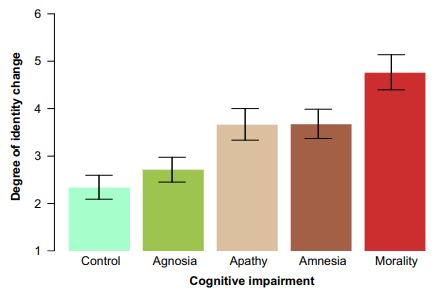] --- # The essential moral self .footnote[Strohminger & Nichols (2014)] #### Method (study 2) > **Prompt:** Imagine that pills have been developed that, once swallowed, would permanently alter only one part of a person’s mind, without affecting anything else. - Participants rated how much the person would change after taking the pill from 0% = "They're the same person as before" to 100% = "They're completely different now" --- # The essential moral self .footnote[Strohminger & Nichols (2014)] .smaller-picture[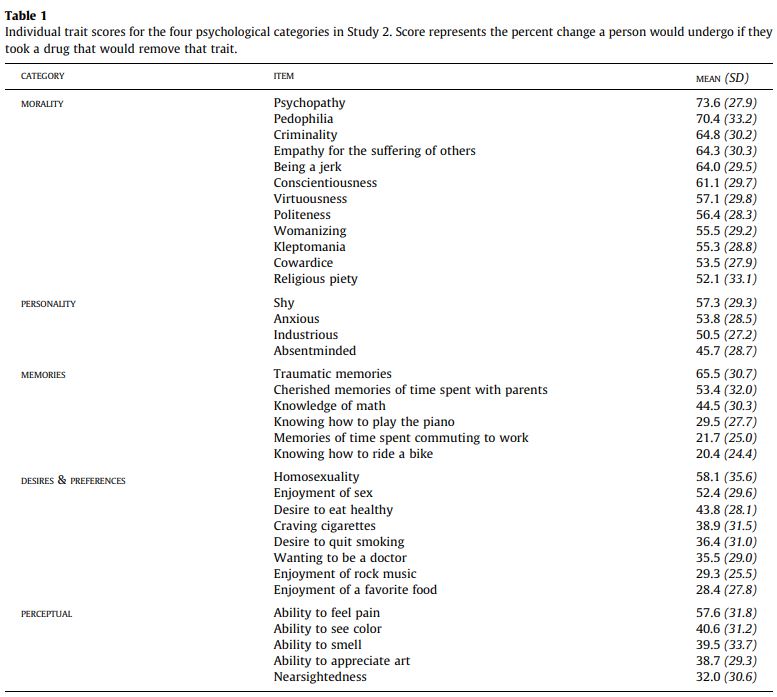] --- # The essential moral self .footnote[Strohminger & Nichols (2014)] .pull-left[#### Results (study 2) .smaller[- Participants considered the person most changed when their morality changed, followed by personality, then memories and desires (which didn't differ from each other), followed by perceptual ]] .pull-right[ 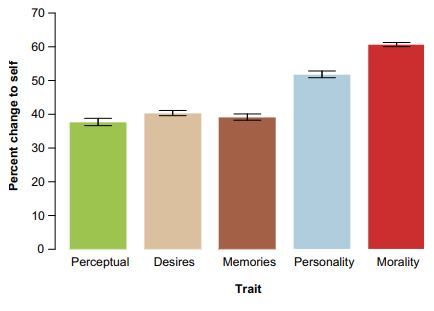] ??? - These findings were also replicated in a soul switch scenario (study 3), a reincarnation scenario (study 4), and meeting an old friend after 25 years scenario (study 5) --- # Neurodegeneration .footnote[Strohminger & Nichols (2015)] In a follow up study, Strohminger & Nichols (2015) wanted to apply the theory to real cases of brain damage (FTD, AD, and ALS) .smaller[- **Fronto-temporal dementia (FTD)**: leads to moral impairments, like dishonesty reduced empathy, diminished concern for social norms, and inappropriate behavior - **Alzheimer's disease (AD)** : episodic/ autobiographical memory loss, confusion, memory loss for generic information, semantic memory loss - **Amyotrophic lateral sclerosis/ Lou Gehrig's disease (ALS)**: a motor neuron disease that results in the loss of voluntary muscle control (leads to a loss in ability to speak and eventually, the ability to breathe)] --- # Neurodegeneration .footnote[Strohminger & Nichols (2015)] #### Method Friends and family of patients with FTD, AD, and ALS were asked questions about whether their loved one has fundamentally changed .smaller-picture[] --- # Neurodegeneration .footnote[Strohminger & Nichols (2015)] .pull-left[#### Results .smaller[- There was no difference between impact on daily functioning between patients of FTD, AD, and ALS - Loved ones rated variables related to identity as most fundamentally changed for FTD patients, and AD patients as moderately changed, and ALS patients as the least changed] ] .pull-right[ 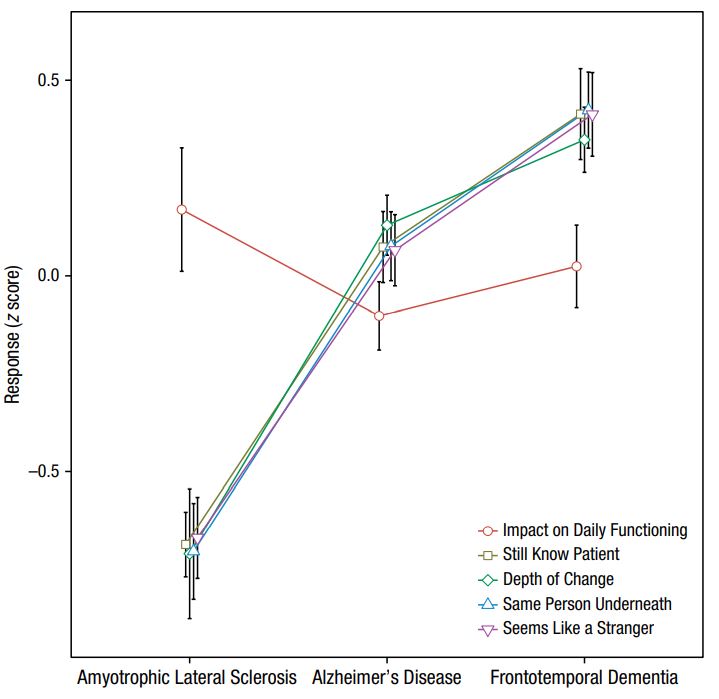] --- # Neurodegeneration #### Discussion .footnote[Strohminger (2018)] Other research in social psychology emphasizes the usefulness of our identities to **distinguish** us from our group However, across these studies, morality has been found to be an extremely important part of one's identity, more important that qualities that distinguish us from each other, like non-moral personality traits and memories. Indeed, when someone loses their moral conscious, we believe them to have fundamentally changed -- .dq[ Why do you think that morality is so central to identity? ] --- # Neurodegeneration .footnote[Strohminger (2018)] #### Discussion - Even though others are constantly changing (e.g., physical attributes, desires, personal qualities), we have evolved to see people as containing a "soul," or some entity that does not change over time - The belief in this unchanging (moral) entity allows us to trust our social partners and to ascribe blame and punish others for harmful actions - If we didn't believe that morality was constant, then we could not live together cooperatively --- # Your "true" self .footnote[Strohminger, Knobe, & Newman (2017)] Strohminger et al. (2017) argue that people think of themselves and others as having a "true" self that is distinct from their actual self > *A close examination of certain cases illustrates how the self concept, as a whole, differs from the true self. Consider the musical Grease, where Sandy sheds her goody-goody persona to become a leather-clad, pelvisthrusting bad girl. Surely all this smokiness and gyration is Sandy. But just as surely, this is a performance designed to gain the approval of her peers, not the “real” Sandy.* .right[-Strohminger et al. (2017)] --- # Your "true" self .footnote[Strohminger, Knobe, & Newman (2017)] Your "true" self differs from your actual self in a few important ways: 1) The true self emphasizes moral features - Moral traits are extremely important when describing our *true self*; when we no longer have the same moral traits and make the same moral judgments and decisions, we become a "different person" --- # Your "true" self .footnote[Strohminger, Knobe, & Newman (2017)] Your "true" self differs from your actual self in a few important ways: 2) The true self is positive by default - We tend to think of the "true self" as overwhelmingly *good* - When someone tries to be a better person, they are trying to become their "true self" - When someone does something bad, we say "that's not who they really are"; "deep down, they are a good person" --- # Your "true" self .footnote[Strohminger, Knobe, & Newman (2017)] Your "true" self differs from your actual self in a few important ways: 3) The true self is perspective independent - For most things, we judge the actions of others more harshly than we judge our own, e.g., if you get a bad grade than it was the situation and if someone else gets a bad grade, than it is their abilities (FAE) - It doesn't matter if you're thinking about the true self of yourself or the true self of another, you consider the true self *moral* and *good* --- # Your "true" self .footnote[Strohminger, Knobe, & Newman (2017)] Your "true" self differs from your actual self in a few important ways: 4) The true self is cross-culturally stable - These findings appear (that we view the true self is moral, good, and the same whether you are judging yourself or someone else) to be the same across cultures, even in cultures that have different conceptions of the self --- # Moral identity .footnote[Blasi (1984); Aquino & Reed (2002)] **Moral identity:** how committed a person is to thinking and acting *morally*; the unique combination of moral traits (e.g., kind, honest, generous, trustworthy) that a person considers closely tied to their self-concept -- .dq[.smaller[What moral traits do you consider most important to your identity?]] --- # Moral identity .footnote[Blasi (1984); Aquino & Reed (2002)] - Two people can have varying moral identities; e.g., one person can consider being compassionate as most important to their moral identity, while other person can consider being honest as most important to their moral identity - There exists a set of traits that are common to most people's moral identity - People with very strong moral identities may be able to resist acting unethically, even when the situation makes it very easy to - We are motivated to maintain self-consistency --- # The moral identity scale .footnote[Aquino & Reed (2002)] .pull-left[#### Pilot study - In order to measure moral identity, Aquino & Reed (2002) first needed to create a list of moral traits - First, they asked people about qualities that a moral person possess - They reduced responses down to 9 traits ] .pull-right[ 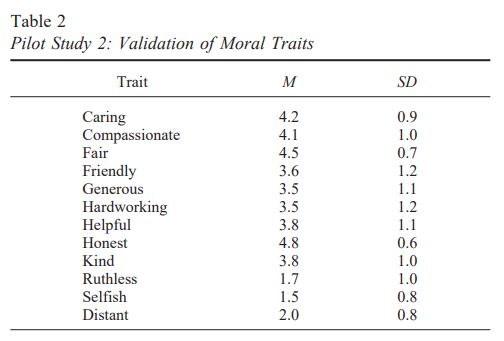] ??? In a second pilot study, they asked people about how necessary is it that a moral person possess each trait (from 1 to 5). They used a neutral item (distant) and two negative items (selfish and ruthless) in that study --- # The moral identity scale .footnote[Aquino & Reed (2002)] #### Method (study 1) To develop the moral identity scale, Aquino and Reed (2002) presented the nine moral traits (e.g., caring, compassionate) and the following prompt: > .smaller[Listed below are some characteristics that may describe a person [list of nine traits]. The person with these characteristics could be you or it could be someone else. For a moment, visualize in your mind the kind of person who has these characteristics. Imagine how that person would think, feel, and act. When you have a clear image of what this person would be like, answer the following questions.] --- # The moral identity scale .footnote[Aquino & Reed (2002)] #### Method (study 1)  --- # The moral identity scale .footnote[Aquino & Reed (2002)] #### Method (study 1) - The researchers analyzed the responses with **principle components analysis** (PCA) - PCA determines how many factors underlie a list of items - Items on a factor correlate strongly with each other, but do not correlate strongly with items on other factors --- # The moral identity scale .footnote[Aquino & Reed (2002)] #### Results (study 1) - In this case, PCA determined a two factor structure .smallish-centered-picture2[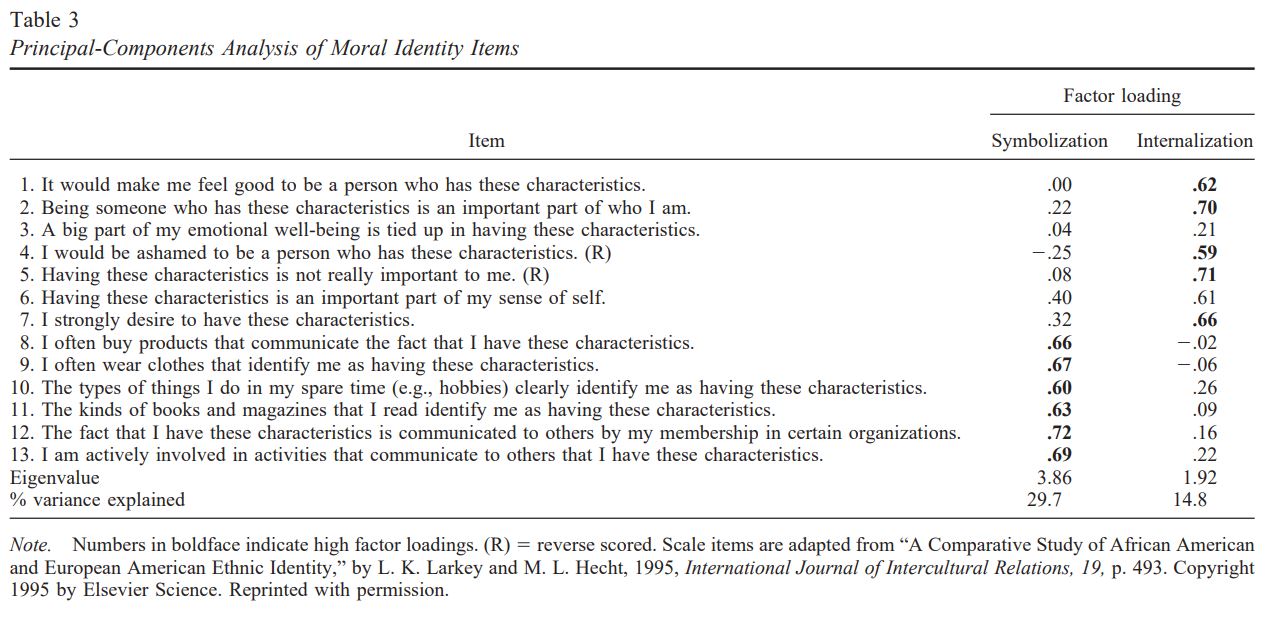] --- # The moral identity scale .footnote[Aquino & Reed (2002)] #### Results (study 1) - Factor 1 (**Symbolization**) - The extent to which the traits given are reflective of the respondent's actions - E.g., "I often buy products that communicate the fact that I have these characteristics" --- # The moral identity scale .footnote[Aquino & Reed (2002)] #### Results (study 1) - Factor 2 (**Internalization**) - The extent to which the traits are central to the respondent's self-concept - E.g., "Being someone with these characteristics is an important part of who I am" ??? The public vs. the private self --- # The moral identity scale .footnote[Aquino & Reed (2002)] #### Method (study 5) - Participants were asked if they had volunteered at a local homeless shelter, helped feed the hungry, organized a food drive, mentored troubled youth, and visited patients at a nursing home in the past two years - They also filled out the moral identity scale --- # The moral identity scale .footnote[Aquino & Reed (2002)] #### Results (study 5) .smallish-centered-picture2[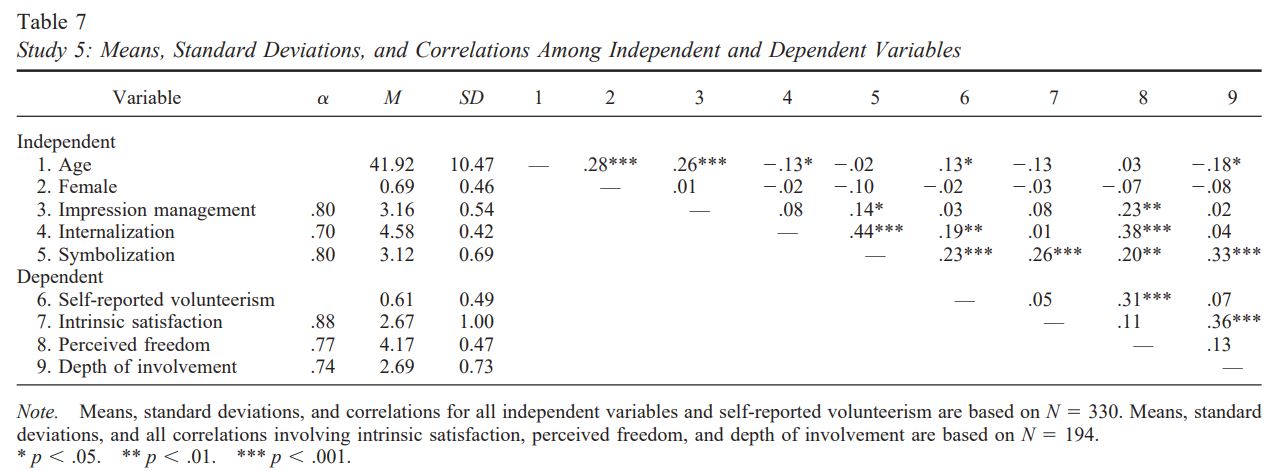] .dq[.smaller[What did the researchers find? What can we conclude?]] --- # The moral identity scale .footnote[Aquino & Reed (2002)] #### Method (study 6) A high school teacher gave the following instructors to her students: > .smallish[For the next 2 days, I will place a box near the front of the class in which you may deposit different food items that I will then donate to [the teacher stated the name of a local charity that donates food to the needy]. It is entirely up to you whether or not to donate any food items, and whether you do so or not will have no effect on your grade in the class. You can give as many food items as you want, as long as the items are not perishable. This means that you should not donate fresh fruits, meats, vegetables, or any food that needs to be frozen. Canned foods, prepared foods that can be stored in the cupboard, or powdered drink or soup mixes are all fine.] --- # The moral identity scale .footnote[Aquino & Reed (2002)] .smallish-centered-picture2[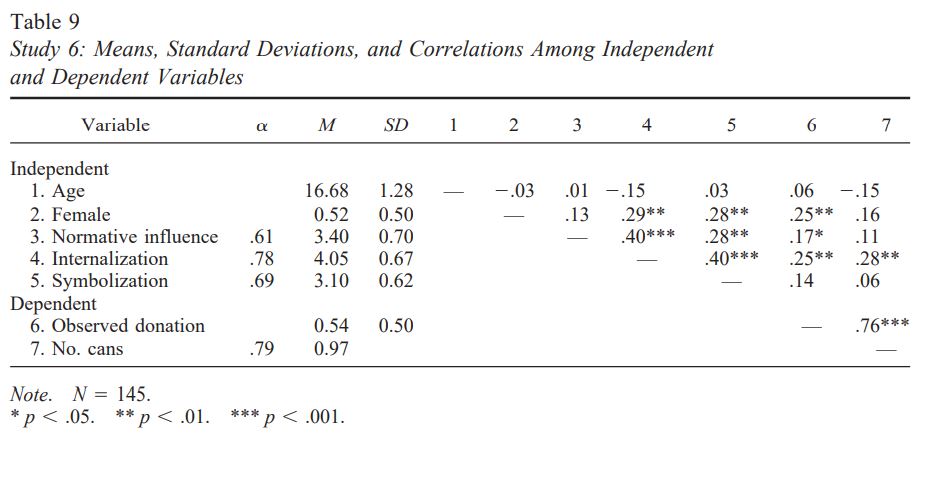] .dq-l[.smaller[What did the researchers find?]] -- .dq[.smallish[What is different compared to the last finding, and how might we explain the discrepancy?]] ??? Symbolization (public behavior) is associated only with self-report behaviors but internalization (private behavior) is associated with self-report and actual behavior --- # The social-cognitive model .footnote[Aquino et al. (2009); Aquino & Kay (2018)] - The .highlight-blue[social-cognitive model of moral identity] acknowledges that people have many identities - Which identity/ identities are salient in any given moment is determined by the situation (e.g., a "private" self, a "public" self, a "family" self...) - Your different identities have different goals and values, so being in different situations yields different selves, and therefore yields different behaviors - Contrasted with the trait view of moral identity (people are *inherently* good or *bad*) --- # The social-cognitive model .footnote[Aquino et al. (2009)] #### Method - Half of the participants were asked to list as many of the 10 commandments as they could (experimental group) and half of the participants were asked to list the 5 largest cities in the US (control condition) --- # The social-cognitive model .footnote[Aquino et al. (2009)] #### Method - Participants read the following scenario: >.smallish[Please imagine that you are the brand manager for a breakfast cereal company. Recently, you were approached by the American Cancer Society (ACS) to initiate a cause-related marketing program. Specifically, ACS would like you to donate 25 cents to a special fund for cancer prevention each time one of your products is purchased. According to your research department, adoption of the program is likely to cost more than it earns through an incremental sales increase. Consequently, IF YOU CHOOSE TO INITIATE THE PROGRAM, YOU WOULD BE LESS LIKELY TO EARN A YEAR-END BONUS. *How likely are you to initiate the cause-related marketing program?*] ??? Participants were business students --- # The social-cognitive model .footnote[Aquino et al. (2009)] #### Results - People who were primed to think about morality by reporting the 10 commandments behaved more pro-socially - Additionally, being reminded of the 10 commandments had a larger effect on pro-social behavior when *one had a low moral identity internalization score* (i.e., morality is not central to their identity) - Similarly, in a follow up study, they found that a tempting situation (to lie in a business negotiation for a bonus) had a larger effect on pro-social behavior when *one had high moral identity internalization scores* (i.e., morality is central to their identity) --- # Summary - Morality is essential to how we perceive the identity of others - When someone changes in their moral traits (e.g., becomes less honest), we consider them fundamentally different; they aren't acting like their "true self," or they are just not the same person anymore - The cognitive-social theory of moral identity posits that we have multiple identities that are salient in different contexts - Thus, by priming one to think about their *moral self*, we can increase pro-social behavior .highlight-blue[Next class:] self-concept maintenance